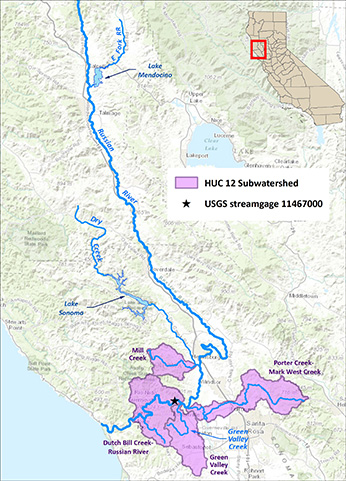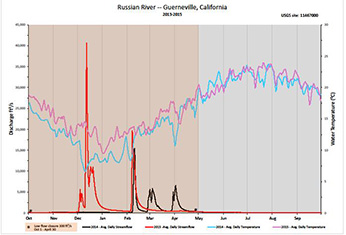(Russian River Watershed, Sonoma and Mendocino counties)
Species / Location

Figure 2. Map of the Russian River watershed and the four key watersheds that drought conservation measures were focused on during 2014-15.
The Russian River and its tributaries support populations of federally threatened California Coast Chinook salmon (Onchorynchus tshawytscha) and Central California Coast (CCC) steelhead (O. mykiss), in addition to the state and federally endangered CCC coho salmon (O. kisutch) (Figure 1). The three salmonid species of the Russian River exhibit an anadromous life cycle in which they rear in freshwater, out-migrate to the marine environment, and then return to freshwater to spawn. The timing and spatial distribution of these species in the watershed varies by species and life history stage. They typically arrive in Russian River as adults in the fall and winter, and spawn in the mainstem and tributaries. After hatching, juveniles rear for varying amounts of time in freshwater before heading out to sea.
Coho salmon are the least abundant salmon in the watershed and were functionally extirpated in 2001. That year, the Russian River Coho Salmon Captive Broodstock Program was created by the California Department of Fish and Wildlife (CDFW), the National Marine Fisheries Service (NMFS) and the U.S. Army Corps of Engineers (Corps) to recover the Russian River coho salmon population. The program is currently the primary coho salmon broodstock program in central California, supporting not only the Russian River but the entire population in the Central California Coast (CCC) Evolutionary Significant Unit, from Southern Humboldt County through Santa Cruz County.
Steelhead are the most abundant and widely distributed salmonid in the Russian River. They return to the river in the late fall through spring to spawn in tributaries. The Russian River has the largest steelhead fishery in the Central California Coast. The wild steelhead population is supplemented by hatchery stock reared at the Warm Springs Fish Hatchery, located on Dry Creek, tributary to Russian River, and at the Coyote Valley Fish facility, located on the East Fork of the Russian River. Both the hatchery and fish facility are operated by the Corps and were built as mitigation for the construction of dams on Dry Creek (Lake Sonoma) and on East Fork of the Russian River (Lake Mendocino).
The Russian River Watershed is a large coastal watershed with over 200 tributaries that encompasses 1,485 square miles. It flows 110 miles from its headwaters in Mendocino County to its mouth at the Pacific Ocean in Sonoma County (Figure 2). It is critical habitat for fish and wildlife as well an important water supply for communities within Mendocino, Sonoma, and Marin Counties.
The Russian River is managed as a regulated water conveyance and flood control system. Flow is controlled by releases from the two major reservoirs, Lake Sonoma and Lake Mendocino. The Russian River also receives water from the Eel River through the Potter Valley Project, which flows into Lake Mendocino.
Need for Drought Stressor Monitoring
Balancing the human demands on the Russian River and the need to recover listed salmonid populations is a complex issue. The National Marine Fisheries Service (NMFS) Russian River Biological Opinion and the State Water Resources Control Board (SWRCB) provide much of the regulatory requirements for flow in the river. Federal and state salmonid recovery plans have identified the Russian River as a key watershed in the long-term recovery of Chinook salmon, coho salmon, and steelhead. Amidst a historic drought, the most important issue facing the recovery and continued survival of salmon and steelhead in the Russian River is maintaining adequate instream flows that provide sufficient water quantity and quality for survival during drought conditions.
Maintaining adequate flows in the Russian River was established as a top conservation priority through a multi-agency drought prioritization process conducted in response to a request by the SWRCB to identify fisheries resources at greatest risk due to the drought. Biologists from NMFS, CDFW, and the US Fish and Wildlife Service (USFWS) developed a structured decision-making model to integrate considerations such as drought severity, anthropogenic water demand, and importance of each watershed to the recovery of coho salmon and steelhead. The Russian River emerged as the highest priority watershed as a result of this exercise.
The Russian River tributaries Mill, Dutch Bill, Mark West, and Green Valley creeks (Figure 2) have historically maintained perennial flow during dry years and as such, are important sites for coho salmon and steelhead recovery. Since 2004, juvenile coho salmon raised in the hatchery have been released into many Russian River tributaries, with Mill, Green Valley, Dutch Bill, and Mark West Creeks comprising almost 46.5% of all releases (476,020 of 1,024,219). Monitoring of coho salmon populations in the Russian River basin has shown that these tributaries play an important role in providing critical habitat for rearing juveniles. These tributaries also support important steelhead populations.
Stressor Monitoring Efforts and Findings
The initial drought stressor monitoring conducted for the Russian River utilized existing USGS stream gages (Hopland, Cloverdale, Healdsburg, and Guerneville) to monitor stream flow and water quality (temperature and dissolved oxygen). These gages were used to determine real time conditions of the river in relation to water supply management and drought conditions (Figure 3). This was coupled with visual observations and photo documentation of sites within the watershed. CDFW recognized early in the drought stressor monitoring effort that the historically low stream flows inhibited the movement of vulnerability to mortality from predation, physiological stress, and fishing in the lower Russian River (Figure 4).

Figure 3. Streamflow, water temperature, and sport fishery Low Flow closure time period as measured at the USGS stream gage 11467000 near Guerneville, California during 2014 – 2015.

Figure 4. Shore and boat anglers at Johnson’s Beach on the lower Russian River, January 14 2012 at 248 cubic feet per second per USGS stream gage at Guerneville, CA. Photographer: Joshua Fuller, NOAA
CDFW determined that recreational fishing in addition to drought-related environmental stressors, such as high water temperature, poor water quality, and access to spawning habitat, could seriously affect reproductive success and adult survival rates of migrating salmonids. On February 5, 2014, CDFW petitioned the Fish and Game Commission to enact an emergency closure of the recreational fishery on the Russian River to eliminate angling as an additional stressor (see Figure 4). The Fish and Game Commission adopted the emergency closure.
As drought conditions continued throughout 2014, CDFW proposed a regulation change to establish Special Low Flow Conditions from October 1-April 30, for the Russian River. The new regulation established low flow conditions for the Russian River based on the stream gage near Guerneville. The low flow closure prevents fishing when stream conditions fall below the minimum flow of 300 cfs at the gaging station located on the main stem Russian River near Guerneville (Sonoma County). This regulation was adopted and went into effect on February 23, 2015.
The creation of the low flow closure for the Russian River provides CDFW with a management tool to reduce fishery impacts to listed salmonid species when either the natural in-river conditions inhibit migration or when periodic artificial breaching of the bar-built lagoon / estuary for flood control purposes allows salmonids to enter the river during unfavorable conditions.
Future Efforts

Figure 5. Mill Creek, Sonoma County September 30 (left) and December 3, 2015 (right).
A dominant theme emerging as a result of the drought is the importance of summer flow for survival and the subsequent need to protect summer stream flows (Figure 5). Drought conditions have created poor summer aquatic habitat conditions which require immediate attention (Figure 6). However, the lack of site specific information on summer flow conditions provide an impediment to developing specific summer flow recommendations to protect imperiled coho salmon populations. To assess drought-associated impacts to fish and wildlife, including the minimum flows needed to provide a chance for survival of listed anadromous fish, summer flow criteria for juvenile salmonids need to be developed for priority coho salmon streams. Specific stream reaches considered to be at greatest risk of desiccation during drought conditions shall be selected using wet/dry and thalweg depth data.
CDFW worked collaboratively with NMFS, local landowners, and the SWRCB to address ongoing conditions resulting from the drought by developing voluntary drought agreements with local landowners.

Figure 6. Desiccated juvenile coho salmon found in dry back reach of Green Valley Creek, Sonoma County, in 2015.
In order to communicate the dire conditions in these watersheds and to encourage landowner cooperation, CDFW also participated and organized multiple outreach meetings to educate landowners on water diversion effects on instream flows and to facilitate the Voluntary Drought Initiative process. These agreements provided critical instream flows for coho salmon and steelhead in four tributaries including Mill, Mark West, Dutch Bill and Green Valley creeks. In 2015, three landowners entered into voluntary agreements for flow enhancement projects by releasing stored water to enhance summer flows for coho salmon.
In addition, the recent drought and concurrent outreach efforts in these four tributaries to the Russian River have made it clear that many landowners are unaware of their diversions’ effects on instream resources or the need for specific permits or authorizations. Outreach efforts should focus on educating landowners about their rights and responsibilities as they pertain to wells and stream diversions and on soliciting participation in projects that would coordinate summer releases in priority streams. CDFW will also promote, fund and assist watershed groups with flow-specific charters to develop and implement additional education forums for stakeholders on instream flow issues. Efforts shall also be expanded to other specific watersheds within the CDFW’s Bay Delta Region with potential current or near future presence of coho salmon. This will include continuing education, outreach and media interaction, as well as additional instream flow data collection and monitoring.